
|

|
Forum Index : Solar : Epever Tracer 4215BN & Lithium Batteries
| Page 1 of 3 |
|||||
| Author | Message | ||||
| Finn Newbie Joined: 16/01/2018 Location: AustraliaPosts: 15 |
G'day Everyone, I bit the bullet and purchased a 12V 130AH Lithium battery pack along with a GNE balancer and a Cell log 8 monitor for a mobile home setup and would love some advice please. I have an Epever Tracer 4215bn MPPT solar regulator , would you consider this suitable for charging lithium batteries? Also would I be better of using 12 or 24 volt panels 200W? The Tracer 4215bn is user programmable. Cheers and Thx |
||||
| davef Guru Joined: 14/05/2006 Location: New ZealandPosts: 499 |
LiFePO4? Is it user programmable for your specific type of Lithium batteries? If MPPT then 24 Volt panels, as the MPPT will actually be able to work and you can use lighter connecting cables. How many cells? The more cells the higher the Voc. What is the maximum input voltage rating on your charger? |
||||
| Finn Newbie Joined: 16/01/2018 Location: AustraliaPosts: 15 |
G'day Dave, I think the batteries are LiFeP04 "winston cell"I got them from Trev through this site. The tracer is user programmable but not specifically for Lithium. the max input of the solar controller is 520W (12V) or 1040W (24V) and I'm tossing up between 2 or 3, 24Volt panels 200W each. I hope this makes sense and thank you. cheers |
||||
| Tinker Guru Joined: 07/11/2007 Location: AustraliaPosts: 1904 |
Winston cells are LYP (lithium yttrium polymer I think) technology. Look up the winston site for charging recommendations. I have 10Kw of them here, oldest is now 5 years and still performing as new. Klaus |
||||
| yahoo2 Guru Joined: 05/04/2011 Location: AustraliaPosts: 1166 |
Hi finn, yes you can use this controller for lifepo4 although there a couple of BUT's first one is not a biggie, you need to not use the RTS remote temp sensor so that the voltage is not adjusted for temperature and remains fixed at the 25 degrees setting. if you dont do this the batteries will overcharge in really cold conditions. second thing is there is two types of mppt controllers. The expensive ones can transform a higher voltage to a lower one, the cheapies dont do that they work inside a limited range. so using 24v panels on a 12v battery will probably be outside of the mppt range, they might still work but there will be quite a bit of current loss. if you are playing around with junk panels it is not going to matter, if you are spending your hard earned on proper gear you would be better off using 12v panels with 12v battery and 24v panels with 24v. if you want to get started in a hurry you can use the gel setting to start with and play with the user settings later, the boost voltage might be a tiny bit low for Trev's cells but it is close enough. I'm confused, no wait... maybe I'm not... |
||||
| davef Guru Joined: 14/05/2006 Location: New ZealandPosts: 499 |
Finn, I was asking about the maximum PV input voltage rating not power. My Tracer 2210RN MPPT controller can work on 12 and 24V systems and the maximum input voltage is 100VDC. The efficiency at higher PV input voltage value drops a few percent but you might have an overall gain considering cable loss. There might be some graphs at the back of your manual. Other main concerns about LiFePO4 is effective and appropriate LVD and HVD. The SolarBMS that I use is from electrodacus.com, but I have also got my own analogue-based LVD and HVD "wrapped-around" this unit as I do NOT want to take any chances in damaging the batteries. Dave |
||||
| Finn Newbie Joined: 16/01/2018 Location: AustraliaPosts: 15 |
G'day Dave, Thx also To Tinker and Yahoo2 After a bit more research the max PV input is 150Voc. The Batteries are LYP (lithium yttrium polymer) not LiFePo4 I made a mistake, I am waiting for my batteries should arrive this week, I purchased a Cellog 8M cell voltage monitor. Yahoo2 I have a decent MPPT controller that can handle 150Voc, is it safe to use 24V panel on my 12v system? Cheers Guys |
||||
| yahoo2 Guru Joined: 05/04/2011 Location: AustraliaPosts: 1166 |
LYP or LFP there is not much difference if dave thinks it will work I will bow to superior knowledge i dont deal with tracer gear much. I'm confused, no wait... maybe I'm not... |
||||
| Finn Newbie Joined: 16/01/2018 Location: AustraliaPosts: 15 |
I haven't purchased panel yet I'm unsure what to get should I get two 12V 200w or 24V200w does it matter? I only have a 5-meter run as I'm setting it up in a motorhome. Cheers trying to get my head around it all |
||||
| davef Guru Joined: 14/05/2006 Location: New ZealandPosts: 499 |
Hang on a minute! Do your own research. This is the way I read my Tracer manual. Also, I thought it was a commonly used technique to allow the use of less copper getting the power from the panels to the battery. What brand of LYP batteries are you going to use? I suggest it would be worthwhile reading the user manual provided by electrodacus. half way down the page |
||||
| davef Guru Joined: 14/05/2006 Location: New ZealandPosts: 499 |
Finn, Sorry, I see you mentioned Winston. I have the same. For a 5 metre run at 200Watts of PV I would suggest sticking with "12V" panels. What range of LVD and HVD can your controller be programmed for? |
||||
| yahoo2 Guru Joined: 05/04/2011 Location: AustraliaPosts: 1166 |
it depends, if you are on the move a lot you would be better off with smaller 80 or 100w panels the big ones can flex and vibrate and crack the silicon in the cells. also you dont want any shadows if you can help it, shade on a single cell will pretty much stop that string from producing energy. motorhome roofs can be a bit lumpy, plenty of stuff to cast a shadow. I had a look at the manual and they show conversion efficiencies up to 66 volts on a graph for a 12v battery, that would be a pair of 24v panels in a string. the way the numbers match up I would guess they have designed this controller to fit 250w 60 cell panels. I'm confused, no wait... maybe I'm not... |
||||
| Boppa Guru Joined: 08/11/2016 Location: AustraliaPosts: 814 |
I dont know about that yahoo2, I had no issues running 2x250w panels on the roofracks of an explorer for over 2 years, and it had some pretty serious offroad work, plus plenty of corros on gravel tracks and I had no issues with the panels- wiring yes but not the panels (the screw terminals on the reg kept coming loose,eventually I soldered them on permanently  eta well over 2 years- a year here, a year in Tara, a year in prossy,year and a half in maccy-4 1/2 years |
||||
| yahoo2 Guru Joined: 05/04/2011 Location: AustraliaPosts: 1166 |
You must have got something right there Boppa. Either they are good quality panels/ frames, the old ford is well sprung or they are well mounted! I have seen quite a few big panels on single axle camper trailers that are electrically shagged, maybe I just dont see the ones that are working cos they dont need replacing. I'm confused, no wait... maybe I'm not... |
||||
| Boppa Guru Joined: 08/11/2016 Location: AustraliaPosts: 814 |
they were good german mono ones but expensive as, cant really see them that well but just right angle shelve legs from those cheap metal bunnings shelf units to mount them to the roof racks, and a couple of legs at the front through the roof cause the roofracks didnt go fair enough forward and the front panel used to flex up and down when semis went past. I liked them as each individual string had its own diode, so even if they got some shade on it, as long as it didnt go from one side to the other, you would still get some output- handy when camping. Rated @ 500w, regularly got 46A out of them even lying flat- only drawback was they had a 'pebbly' surface which did work well in spreading the charge times out, but jeez did it collect the dirt!!! |
||||
| Finn Newbie Joined: 16/01/2018 Location: AustraliaPosts: 15 |
Cheers Guys  I must say Im a little confused now. Dave is the electrodacus a charge controller and a Bms and what would be considered overvoltage for Lithium Battery cells? Many thanks |
||||
| Boppa Guru Joined: 08/11/2016 Location: AustraliaPosts: 814 |
The Bms is a balancer- it simply keeps the cells equal in voltage eg say you have 3 cells @ 3.2v and the fourth is at 3.7, it will gradually balance them all out until they all end at say 3.4v- nice and equal- it isnt a charge controller and simply connects across each cell The charge controller is separate and does a completely different job- both are required and do completely different jobs The 8 cell monitor is just that- a programmable (and very flash looking) voltage gauge- it requires a wire running back to each individual cell- note that those wires an individually deliver the full current from that cell!!!- I wired the utes ones up to a individual connection fuse box and fitted 300ma fuses and ran 5 core trailer wire to the monitor 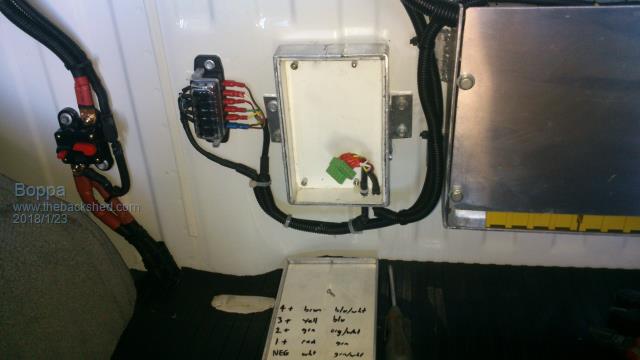 fusebox and housing for balancer 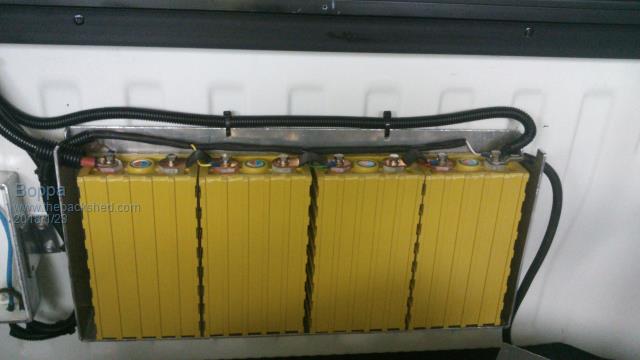 batts and 5 core trailer cable to balancer and monitor 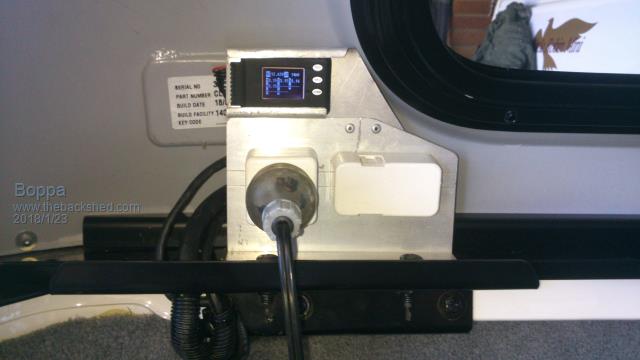 8 cell monitor and fridge outlet 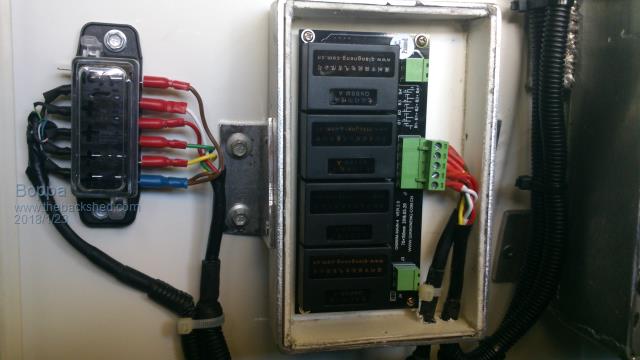 Balancer and fusebox to monitor |
||||
| Finn Newbie Joined: 16/01/2018 Location: AustraliaPosts: 15 |
Thanks for clearing that up Boppa. I have the same 8 cell monitor and Balancer, what size wire did you run from the battery to the Fuse Box or was it the same 5 core trailer wire? Is that a cartridge type fuse holder? Do you have a heatsink attached to your battery balancer? What is considered overvoltage for LYP batteries and what level should I set my disconnect? with my Epever Tracer 4215BN in user mode, I do not seem to be able to set the overvoltage disconnect below 16v eaton-bussmann-series/bk-gma-300-r/fuse-cartridge-300ma-5x20mm-fast/dp/48K9535 is this suitable? Thanks everyone for your advice I thought this was going to be a simple change over I was wrong, I want to be sure I got this worked out before I try and hook up my new Batteries . Cheers |
||||
| Boppa Guru Joined: 08/11/2016 Location: AustraliaPosts: 814 |
I started off using telephone cable (8 core) running from the monitor to the balancer with 5 core trailer from the balancer to the batteries but found the phone cable was too prone to fracture with vibration (this was multistrand, not solid- it tended to snap off at the crimps) so replaced the entire run with 5 core trailer wire- its double insulated and meant for car usage- and quite cheap per meter. The fusebox was a 6 way independent fuse fusebox fitted with blade fuses- you need 5 fuses (one for each connection to a cell) I went for the lowest they had in stock at autobarn 500mA- One thing to watch out for is that some fuseboxes have all connections of one side joined together- ie positive would go here and individual circuits taken off each fuse on the other- this is NO GOOD!!!!- you need the one with individual connections on both sides- this is purely a safety thing as you have to run each cell connection from the battery box to the monitor and unless the monitor is in the battery box, it needs protection- as if any of these wires short out- they will deliver the full output of that cell to the short!!! If you look at the pics- my 5 core goes batteries, to balancer (unfused- I am of 2 thoughts about whether it should be fused or not- I let the smaoke out of one due to incorrectly wiring it up-bat 1 is at the NEG end, unlike most truck multibats which normally start at the + end....- fuses probably would have saved it... but it also needs minimal voltage drop etc to work...) then to the fuse box, then to the monitor (which is mounted at the back of the ute body next to the fridge) No heatsink is required for the balancer- it doesnt even get warm in operation, most of the time I doubt it is transferring current at all, its only there to equalise the battery voltages if they start getting out of wack These arent charged by solar, but by the car alternator- I still set the monitor alarms to go off @ 3.7v per cell which is 14.8v- if it ever gets that high theres something wrong with the alternator! For solar most seem to be around 14.4 as their maximum point I have the bottom end cutoff at 11.8v (2.95 per cell) thats above the minimum which is supposed to be 2.5 per cell (10v) but I dont feel that comfortable yet going that low, and I am still getting more actual run time at 11.8 on the 4x 60ahr cells than I was with 2x120ahr L/A batts- and they are a damn sight smaller and lighter! all extra parts came from autobarn and was under $50, any automotive supplier (repco, supercheap etc) should have em...) fuseholder was a NARVA Fuse Box Blade - Product SKU Code: EL03280 - check there are individual connectors on BOTH sides- NOT common railed!!! Fuses are 500mA- dark blue in colour from autobarn as well- dont have a pt number tho Trailer cable is standard 5 core (old fashioned trailer) cable, you can use 7 core but 5 core is easier and cheaper per m 16v is right at the top of the range- it might be prudent to set it to the 16v purely as a OHOH backup, but I would see if there is any way of keeping it lower (most solar regs have their actual charge rate is much lower than 16v- thats where it basically panics and cuts the batteries off if it ever gets that high) 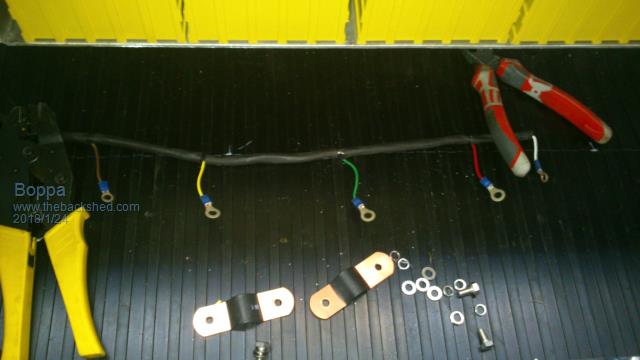 making loom for balancer 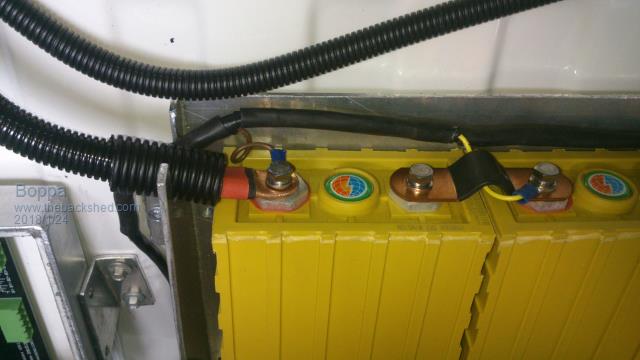 5 core trailer cable to balancer/monitor 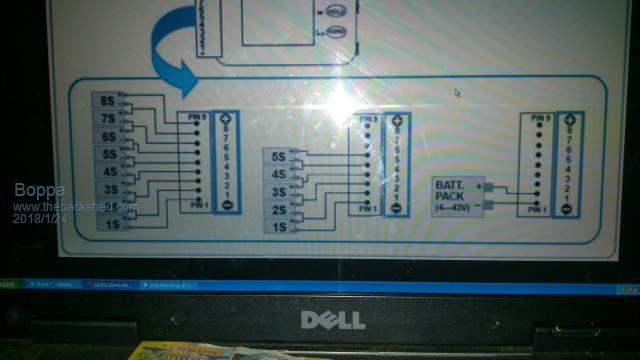 monitor wiring diagram (doesnt come with instructions and cd that came with it wouldnt read in my drive) 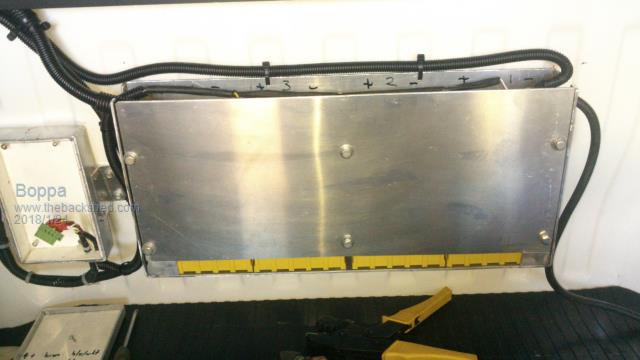 battery connections now marked so you dont do this.... 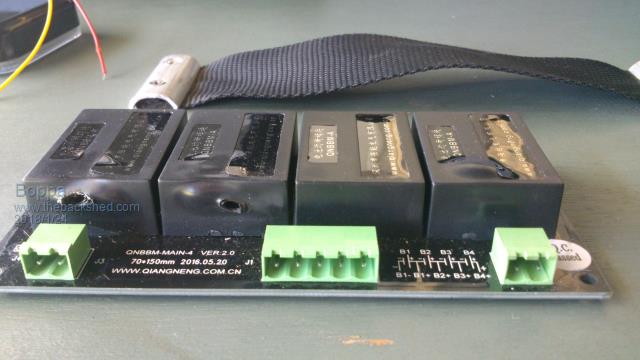 |
||||
| davef Guru Joined: 14/05/2006 Location: New ZealandPosts: 499 |
Yes, it is ... but it is just an ON/OFF controller designed to be used with 60 cell panels (24V) system. Or 12Volt systems (36 cells). His claim, which I believe to be correct, is that if the panel Vmp voltages are just above the battery voltage then MPPT is not going to be of much benefit. HVD is set at 3.75V/cell and LVD 2.8V/cell (22.4V for 8 cells). Charging stops at 3.55V/cell. I have alarms that go off at 3.6V/cell and 3.12V/cell before HVD or LVD kick-in. If your charging does not terminate properly things could get out-of-hand quite quickly on a sunny day. 16V/4 cells is 4V. If you check the Winston data they do say 4V max, but looking at the graphs things are heading for destruction. What can you set the end of charge to? |
||||
| Page 1 of 3 |
|||||